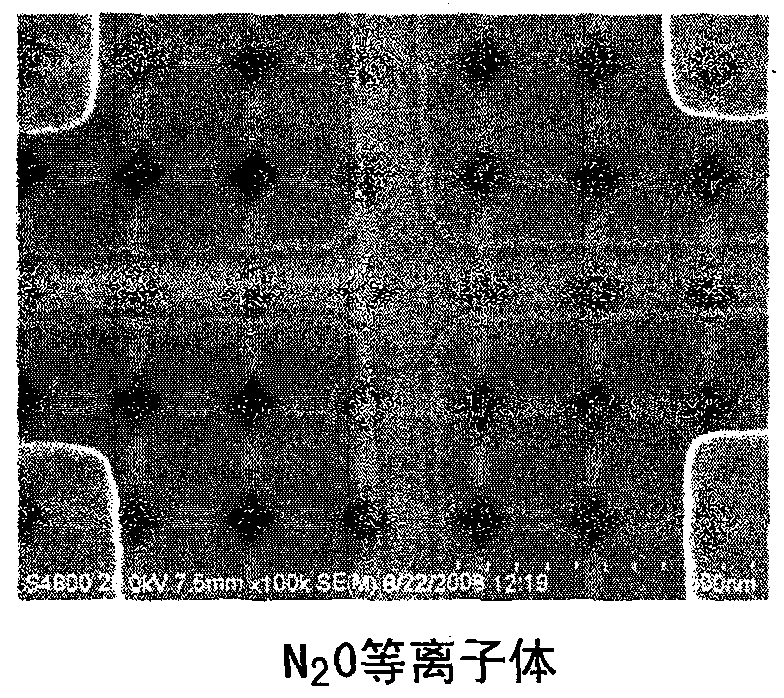Front end of line plasma mediated ashing processes and apparatus
A plasma and ashing technology, applied in semiconductor/solid-state device manufacturing, discharge tubes, electrical components, etc., can solve the problem of low resist removal rate yield, affect device electrical properties, and is not suitable for removing photoresist agent and other issues
- Summary
- Abstract
- Description
- Claims
- Application Information
AI Technical Summary
Problems solved by technology
Method used
Image
Examples
Embodiment 1
[0057] In this embodiment, the photoresist coated on the silicon substrate is exposed to the nitrous oxide in the RapidStrip320 plasma ashing tool available from Axcelis Technologies, Inc. Strip chemicals. The photoresist is an i-line photoresist available from Fuji Company under the trade name 10i, and is deposited on a silicon substrate with a thickness of 1.9 microns. At a pressure of 1 Torr, a temperature of 240° C., and a power setting of 3500 watts, nitrous oxide gas was flowed into the plasma ashing tool at 7 standard liters per minute (slm) to form plasma chemistry.
[0058] The ashing rate, cross wafer uniformity, and oxide growth of the nitrous oxide plasma stripping method were compared with oxygen-free reducing plasma (synthetic gas) and oxygen-based plasma. At a pressure of 1 Torr, a temperature of 240°C, and a power setting of 3500 watts, a reducing plasma is formed from a gas mixture of synthesis gas (3% hydrogen in nitrogen) entering the plasma ashing tool at a f...
Embodiment 2
[0062] In this embodiment, a small amount of CF 4 Added to different plasma gas mixtures and processed in RapidStrip320 plasma ashing tool. The silicon substrate was exposed to different plasma chemistries, and oxide growth was measured. The results are shown in Table 1 below. In each example, at a pressure of 1 Torr and a power setting of 3500 watts, various plasmas were formed using a gas mixture entering the plasma ashing tool at a flow rate of 7 slm. As indicated in the table, CF sprayed into the plasma ashing tool 4 The amount (where indicated) is 20 standard cubic centimeters per minute (sccm).
[0063] Table 1
[0064]
[0065] As shown, as evidenced by oxide growth, CF is sprayed during plasma formation 4 This causes minimal substrate loss, and advantageously, more energetic materials can be expected to be produced, which should effectively increase the ashing rate relative to the results observed in Example 1.
Embodiment 3
[0067] In this embodiment, for the plasma formed by nitrous oxide, the RapidStrip320 plasma ashing tool is used to measure the substrate damage in terms of silicon loss, oxide growth, and oxide loss, and compare it with the presence and absence of a small amount of tetrafluoroethylene. Carbonized O 2 / Compared with the prior art plasma formed by a synthetic gas mixture. The synthesis gas composition is 3% hydrogen in nitrogen. The results are shown graphically in Figure 5A in. In each example, at a pressure of 1 Torr, a temperature of 240° C. and a power setting of 3500 watts, various plasmas were formed using a gas mixture entering the plasma ashing tool at a flow rate of 7 slm. CF sprayed into the plasma ashing tool 4 The amount (where indicated) is 20 standard cubic centimeters per minute (sccm). Substrate damage includes (i) silicon loss from silicon-on-insulator (SOI) test structures, (ii) silicon oxide growth on bare silicon test wafers, and silicon oxide loss from sil...
PUM
 Login to View More
Login to View More Abstract
Description
Claims
Application Information
 Login to View More
Login to View More - R&D
- Intellectual Property
- Life Sciences
- Materials
- Tech Scout
- Unparalleled Data Quality
- Higher Quality Content
- 60% Fewer Hallucinations
Browse by: Latest US Patents, China's latest patents, Technical Efficacy Thesaurus, Application Domain, Technology Topic, Popular Technical Reports.
© 2025 PatSnap. All rights reserved.Legal|Privacy policy|Modern Slavery Act Transparency Statement|Sitemap|About US| Contact US: help@patsnap.com



